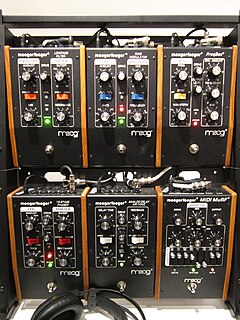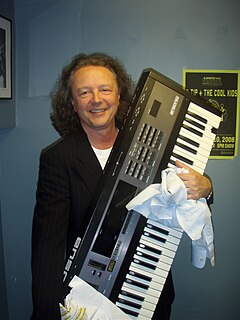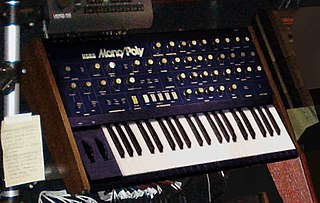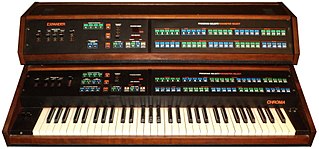The MonoWave is a monophonic 2U 19" rack synthesizer by Modulus Electronics, UK.
Contents

The MonoWave is a monophonic 2U 19" rack synthesizer by Modulus Electronics, UK.

This synth was first shown in 2001 by its inventor Paula Maddox on a PPG user/fan meeting. Because its attraction to some synthesizer players at the event, the project was started with 5 beta-test units to test the software and hardware. By spring 2002. the serial production of a 25-piece limited run started. About a year later, all units were sold.
Late in 2005, after many attempts at designing new products, Paula decided to close Modulus Electronics and its website (modulus-music.com). In order that people could still enjoy the Monowave, she worked with Elby Designs to create a kit version of the monowave offering the same features. The software was released at the same time under the GPL license, in the hope that others would continue to develop its features.

It features two digital oscillators with 256 different single-cycle waveshapes selectable individually. There is also a unique de-res, a function to lower the digital waveshapes' sample resolution, to give a sound very much like the famous German PPG wave synthesizers from the eighties. The signal of these oscillators and their suboctave signals are mixed together and then feed in the pure analog part of the synth, a Moog-style 24 dB transistor-ladder lowpass filter and a VCA. Both of them are controlled by their own ADSR envelope. Depending on the installed operating system version, it may either have an arpeggiator or a MIDI-velocity to wavenumber function.
The MonoWave has no patch memory. It can be played via MIDI by sequencers or MIDI keyboards.
Wavetable synthesis is a sound synthesis technique used to create periodic waveforms. Often used in the production of musical tones or notes, it was first written about by Hal Chamberlin in Byte's September 1977 issue. Wolfgang Palm of Palm Products GmbH (PPG) developed it in the late 1970s and published in 1979. The technique has since been used as the primary synthesis method in synthesizers built by PPG and Waldorf Music and as an auxiliary synthesis method by Ensoniq and Access. It is currently used in hardware synthesizers from Waldorf Music and in software-based synthesizers for PCs and tablets, including apps offered by PPG and Waldorf, among others.

Modular synthesizers are synthesizers composed of separate modules for different functions. The modules can be connected together by the user to create a patch. The outputs from the modules may include audio signals, analog control voltages, or digital signals for logic or timing conditions. Typical modules are voltage-controlled oscillators, voltage-controlled filters, voltage-controlled amplifiers and envelope generators.

The Jupiter-8, or JP-8, is an eight-voice polyphonic analog subtractive synthesizer introduced by Roland Corporation in early 1981.

The Korg OASYS is a workstation synthesizer released in early 2005, 1 year after the successful Korg Triton Extreme. Unlike the Triton series, the OASYS uses a custom Linux operating system that was designed to be arbitrarily expandable via software updates, with its functionality limited only by the PC-like hardware.

Waldorf Music is a German synthesizer company. They are best known for the Microwave wavetable synthesizer and Blofeld virtual analogue synthesizer.

The microKORG is a MIDI-capable digital synthesizer/vocoder from Korg featuring DSP analog modelling. The synthesizer is built in such a way that it is essentially a Korg MS-2000 with programmable step arpeggiator, a less advanced vocoder, lack of motion sequencing, lack of an XLR microphone input, and in a smaller case with fewer real-time control knobs.

The Korg DW-8000 synthesizer was an eight-voice polyphonic hybrid digital-analog synthesizer 61-note keyboard instrument released in 1985. By the time of its launch Korg had already begun a common trend in 1980s synthesizer design: using numerical codes to access or change parameters with its predecessor - the Korg Poly-61, which was widely regarded as the company's first 'knobless' synthesizer. This was a move away from the heavily laden, complex control panels of earlier designs.

Moogerfooger is the trademark for a series of analog effects pedals manufactured by Moog Music. There are currently eight different pedals produced; however, one of these models is designed for processing control voltages rather than audio signal. A sixth model, the Analog Delay, was released in a limited edition of 1000 units and has become a collector's item. Moog Music announced on August 28, 2018, that the Moogerfooger, CP-251, Minifooger, Voyager synthesizers, and some other product lines were being built using the remaining parts on hand and discontinued thereafter.

Palm Products GmbH was a manufacturer of audio synthesizers. Founded and owned by Wolfgang Palm, PPG was located in Hamburg, Germany and, for 12 years from around 1975 to 1987, manufactured an acclaimed and eclectic range of electronic musical instruments, all designed by Palm.

The Korg Polysix(PS-6) is a six-voice programmable polyphonic analog synthesizer released by Korg in 1981.

The Korg Wavestation is a vector synthesis synthesizer first produced in the early 1990s and later re-released as a software synthesizer in 2004. Its primary innovation was Wave Sequencing, a method of multi-timbral sound generation in which different PCM waveform data are played successively, resulting in continuously evolving sounds. The Wavestation's "Advanced Vector Synthesis" sound architecture resembled early vector synths such as the Sequential Circuits Prophet VS.

The Oberheim OB•12 is a Virtual Analog synthesizer, designed and realised by the Italian musical instrument manufacturer Viscount, in production between 2000 and 2005.

The Ensoniq VFX Synth was initially released as a performance type synthesizer in 1989. It was soon followed by the release of the VFX-SD, which included some updated waveforms, a 24-track sequencer and a floppy drive. Both models were equipped with the Ensoniq Signal Processing (ESP) chip for 24-bit effects. The VFX-SD also included two AUX outs, which allowed for a total of 4 outputs from the synth for more routing flexibility. The initial models were 21-voice polyphony, and in latter models of the VFX-SD (I/II) and the SD-1, the polyphony was 32.

The Serge synthesizer is an analogue modular synthesizer system originally developed by Serge Tcherepnin, Rich Gold and Randy Cohen at CalArts in late 1972. The first 20 Serge systems were built in 1973 in Tcherepnin's home. Tcherepnin was a professor at CalArts at the time, and desired to create something like the exclusively expensive Buchla modular synthesizers "for the people that would be both inexpensive and powerful." After building prototypes, Tcherepnin went on to develop kits for students to affordably build their own modular synthesizer, production taking place unofficially on a second floor CalArts balcony. This led to Tcherepnin leaving CalArts in order to produce kits commercially, starting in 1974.
The Roland Alpha Juno series of discontinued keyboards are analog polyphonic synthesizers with a digitally controlled oscillator manufactured by Roland Corporation from 1985 to 1987.

The Korg Mono/Poly (MP-4) is a 44 key "mono-polyphonic" analog synthesizer manufactured by Korg from 1981 to 1984. This keyboard is the sister synthesizer to the Korg Polysix. It has four highly stable voltage-controlled oscillators (VCOs), a 4-pole, self-oscillating low pass filter (LPF), wide modulation capabilities and pseudo-polyphony (paraphony).

The OSCar was a synthesizer manufactured by the Oxford Synthesiser Company from 1983 to 1985. It was ahead of its time in several ways and its later versions were among the few mono-synths of its time to have MIDI. Around 2000 were made.

The PPG Wave is a series of synthesizers built by the German company Palm Products GmbH from 1981 to 1987.

The ARP Chroma is a polyphonic, multitimbral, microprocessor controlled, subtractive synthesis analog synthesizer developed in 1979-1980 by ARP Instruments, Inc. just before the company's bankruptcy and collapse in 1981.

The Yamaha DX21 is a digital controlled bi-timbral programmable analog synthesizer with a four operator synth voice generator which was released in 1985. It uses sine wave-based frequency modulation (FM) synthesis. It has two FM tone generators and a 32-voice random-access memory (RAM), 32 user voices and 128 read-only memory (ROM) factory preset sounds. As a programmable synth, it enables users to create their own unique synthesized tones and sound effects by using the algorithms and oscillators. The instrument weighs 8 kg (17.6 lbs). On its release, it sold for $795.